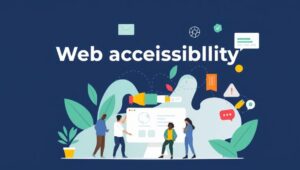The Future of Web Accessibility: WCAG 3.0 and Beyond
Web accessibility is an ongoing effort, and the standards that govern it are constantly evolving to meet the changing needs of users and technologies. The Web Content Accessibility Guidelines (WCAG) are at the forefront of this evolution. WCAG 3.0 is the next major iteration, expected to bring significant changes and improvements to how we approach web accessibility.
What is WCAG?
WCAG provides a set of guidelines for making web content more accessible to people with disabilities. These guidelines are developed by the World Wide Web Consortium (W3C) and are internationally recognized as the standard for web accessibility.
WCAG 2.1: The Current Standard
WCAG 2.1, the current standard, covers a wide range of recommendations for making web content more accessible. These guidelines are organized under four principles:
- Perceivable: Information and user interface components must be presentable to users in ways they can perceive.
- Operable: User interface components and navigation must be operable.
- Understandable: Information and the operation of the user interface must be understandable.
- Robust: Content must be robust enough that it can be interpreted reliably by a wide variety of user agents, including assistive technologies.
Key Changes Expected in WCAG 3.0
WCAG 3.0 aims to be more flexible and easier to understand than previous versions. Here are some of the key changes expected:
- Modular Structure: WCAG 3.0 will likely adopt a more modular structure, making it easier to update and adapt to new technologies.
- Improved Testability: The new guidelines will focus on improving the testability of web content, making it easier for developers to determine whether their content meets the accessibility standards.
- Broader Scope: WCAG 3.0 is expected to broaden its scope to include a wider range of disabilities and user needs.
- Better Guidance: The guidelines will provide more detailed and practical guidance, making it easier for developers to implement accessibility best practices.
- Focus on User Needs: WCAG 3.0 will place a greater emphasis on understanding and meeting the needs of users with disabilities.
Anticipated Timeline: 2025 and Beyond
The timeline for the release of WCAG 3.0 has been under development for several years, and the current expectation is that it will be finalized and released around 2025. However, the exact timeline may be subject to change as the W3C continues to refine and improve the guidelines.
Preparing for WCAG 3.0
As WCAG 3.0 approaches, it’s essential for web developers and content creators to start preparing for the changes. Here are some steps you can take:
- Stay Informed: Keep up-to-date with the latest developments and announcements from the W3C.
- Review Current Practices: Evaluate your current web accessibility practices and identify areas that may need improvement.
- Implement WCAG 2.1: Ensure that your web content meets the current WCAG 2.1 guidelines as a foundation for WCAG 3.0.
- Training and Education: Invest in training and education for your team to ensure they understand the new guidelines and how to implement them.
- Testing: Conduct regular accessibility testing using automated tools and manual reviews to identify and fix any accessibility issues.
Impact on Web Development
WCAG 3.0 is expected to have a significant impact on web development. Developers will need to adapt their practices to meet the new guidelines, which may require additional effort and resources. However, the long-term benefits of improved web accessibility will far outweigh the costs.
Conclusion
The future of web accessibility is bright, with WCAG 3.0 leading the way towards a more inclusive and accessible web for everyone. By staying informed, preparing for the changes, and implementing best practices, we can ensure that our web content meets the needs of all users, regardless of their abilities.




